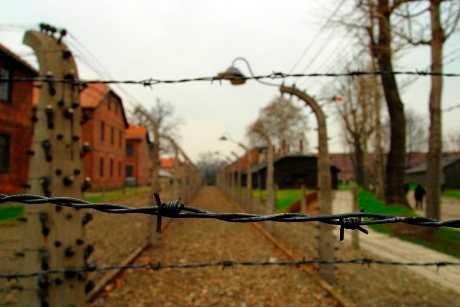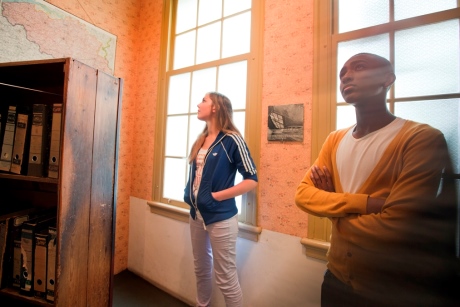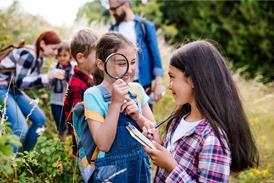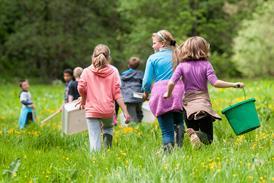
Some LOtC ideas to help educators get to grips with teaching the Holocaust in response to government pleas for better training in the subject.
The Education Select Committee says too few teachers – particularly History teachers – are being trained to teach the Holocaust in England, despite the availability of good Holocaust teaching materials.
Here are some places teachers can take a Secondary school class to learn about the Holocaust outside of the classroom, from The Wiener Library, London to The Jewish Museum in New York.
1. The National Holocaust Centre and Museum, Nottinghamshire
This centre is dedicated to teaching young people about the Holocaust, some of it specifically from the point of view of a young Jewish boy called Leo who is of a similar age to children who might visit.
Through an educational and immersive exhibition called The Journey, students will experience, accompanied by footage and visual artefacts belonging to the boy Leo, what it was like to be of Jewish heritage under the rule of Hitler.
Pupils also get to meet a survivor of the Holocaust and listen to their story; the museum hosts survivors on a daily basis, all of whom share their experiences with visitors and answer questions.
Additionally, a school trip can include exploring the memorial garden and the Holocaust Exhibition.
www.nationalholocaustcentre.net
2. The Imperial War Museum Holocaust Exhibition , London
IWM London houses an award-winning permanent exhibition which traces the Nazi persecution and murder of Europe’s Jews from 1933 to 1945.
On a visit, students will discover how the political climate enabled Hitler to rise to power and how his ideas spread throughout the country, ultimately affecting people all around the world.
Photographs, diaries, toys and film tell the stories of the people who lived through the Holocaust, and testimonies from survivors bring a moving perspective to these objects while a model of Auschwitz-Birkenau demonstrates the extent of events that occurred there.
Learning sessions are available to prebook for a class; children can see original artefacts, documents, photographs, posters and film from the museum collections.
www.iwm.org.uk
3. The Wiener Library, London
This library in London holds original collections of books which relate to several key parts of the National Curriculum for History, including the rise of Nazism in Germany, propaganda, antisemitism and war crimes.
Relating directly to the Holocaust are examples of anti-Nazi pamphlets disguised in ingenious ways, children's handwriting books, official translations of the transcripts of the Nuremberg trials, and personal testimonies from the November Pogrom.
Teachers are able to book workshops at the library also, which can be tailored to learn about propaganda and genocide, the Jewish refugee experience, or resistance and rescue.
Other curriculum subjects, for which the Library can tailor visits to teacher requirements, include Religious Studies, Politics, German Studies, Citizenship, and Art.
020-7637 7247
www.wienerlibrary.co.uk
4. Anne Frank’s House, Netherlands
Located in central Amsterdam, this historic house is where the young Jewish girl Anne Frank hid with her family to avoid falling into Nazi hands.

Pictured: Students at Anne Frank's House, Netherlands. (Photo credit: Anne Frank House, Cris Toala Olivares).
Today the hiding place within the house has been preserved, while the rest of the building forms a museum that is both a memorial to and celebration of Anne Frank’s life.
There are several permanent exhibitions ideal for a school visit, as well as workshops which can be linked to studying the Holocaust and Nazi Germany.
Teachers can book The World of Anne Frank, which is a workshop for pupils over the age of 12. Students are challenged to ask about the choices and decisions made by the Frank family, and the meaning of the word persecution.
Using historic pictures and a concise timeline pupils will learn about Anne Frank, World War Two and the persecution of the Jews. The program can be adapted for different levels and age ranges in Secondary education.
www.annefrank.org
5. Auschwitz, Poland
Between 1941 and 1944 Auschwitz formed a sprawling complex of camps where a staggering 1.1 million prisoners were killed.
Today it is one of the most visited Holocaust memorial sites. Much of the complex remains remarkably intact, and the railway tracks that brought prisoners to the camp are still in place.
School children are able to explore a permanent exhibition that displays items seized from Jewish deportees, as well as documentary photographs, photocopies of documents, models, sculptures, prisoner garments, bunks and other furnishings from prisoner rooms.
Entry is free to the grounds of the memorial site, and teachers can hire a tour guide to provide their pupils with extra information. It’s recommended that visitors be over the age of 14.
www.auschwitz.org
6. The Jewish Museum, New York
The American Jewish Museum houses collections representing Jewish history from ancient to modern times.
School groups can explore 4,000 years of art and Jewish culture through nearly 30,000 important objects spanning fine and folk art, Judaica, antiquities and broadcast media.
A particular collection of Holocaust-related art work is worth visiting for both Art and History purposes.
Work from Anselm Keifer, George Segal and Eleanor Antin shows a variety of takes on the Holocaust and is an ideal place to start when discussing how the representation of the historic event has changed over time.
Teachers can also book a Remembering the Holocaust tour, during which students will discuss, interpret, and establish connections between the events of World War Two and works of art and artefacts related to the Holocaust.
020-7416 5000
www.thejewishmuseum.org









